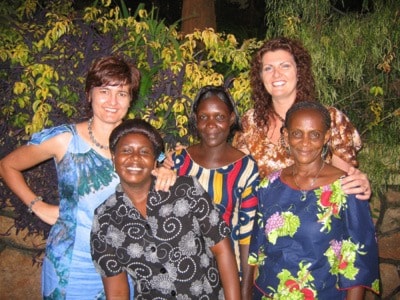In May 2006 Suzanne and Luke Jones sold their house and their vehicles, got on a plane with their four boys, and traded their middle-class lifestyle in Abbotsford for helping orphaned children of wars and the AIDs epidemic that have ravaged Uganda for a generation.
Five years later, they are back in Abbotsford. They are still helping the people of Uganda, but in a new way.
The couple, he a contractor and she a hairdresser, joined a Freshfire Ministries team and built orphanages. The children came to their facilities in Kampala with bloated bellies, badly malnourished and in need of medical attention. The orphanage the Joneses helped to build, thanks in large part to a $40,000 donation from MEI, gave the children a roof over their heads, regular meals, security and an education. They ran the orphanage from 2006 to 2009.
Over time, as she got to know the people, Suzanne said she began to question how much traditional Western charity was really helping the people of Uganda. It happened bit by bit.
She saw orphans cutting up their perfectly good shoes, so they could get new ones like some of the other kids.
She learned some of the so-called orphans had parents, but sent them to the orphanage so they could be educated, and to make life financially easier for the family – Ugandans must pay school fees to have their children educated.
On the contrary, she saw how women who were able to make jewelry or other works of art, which they were able to sell, enjoyed a better standard of living and a feeling of accomplishment and dignity. She bought items, and helped to sell them.
“We noticed such a difference in the women’s lives.”
The GDP (gross domestic product) per capita in Canada is an estimated $39,600 in 2011, and in Uganda it is $1,200. The difference between annual incomes in the two countries is just as vast.
If a Ugandan gets sick with malaria they may have to pray their body can withstand the killer disease, for want of $5 to buy medicine.
Ugandan leaders encouraged the Joneses to expand their efforts in helping women market their hand-made products to Canadians.
While Suzanne agrees there is a need for relief aid when people’s lives are at stake, she said the better long-term solution is foreign investment and economic policies that help the people sell their goods on the international market.
“It’s great to just throw (aid) money there, and it eases your conscience, but there’s a better way to give,” she said. “Money is like a seed. You’re sowing a seed.”
In 2009 they returned to Canada – their sons literally kissing the ground when they got back – and the new venture operates out of Abbotsford.
The walls of the house are lined with baskets of earrings, necklaces, scarves and other products made by Africans. There are two brands, Twigs and the higher end Maisha (‘life’ in the Swahili language). Both can be found at twigzcreations.com. Twigs products can range from as little as $7, and there are many $25 or less. Maisha pieces are more works of art, Suzanne says, and typically range from $40 to $95. The website also shows some of their artists and tells their stories.
Suzanne works with Marike Cooke, a South African she met in Uganda. She deals with the artists, deciding what jewelry they can buy, and helping the women turn their products into something that will sell. Although they offer interest-free loans, and have personal friendships with many of the women, they can’t import unsaleable products.
They have a 50-50 profit sharing arrangement with their artists. They will give their artists seed money to buy materials, generally $100. It’s not always repaid.
But there are more success stories. They floated Mama Rose $250, so she could buy a weaving loom, which she uses to make scarves and wraps. She keeps that loom busy, training and employing other people to help her, and six months later she has paid off the loan and is buying a second loom with her own funds.
The women they work with, most of them widows with families to support, have seized the opportunity.
“Mama Nighty” made necklaces with her kids day and night, until she had made $150 in a month – about what a nurse would earn in her country.
They started with seven artists, and now have over 1,000.
That is the measure of success, because there is little personal financially incentive for the Jones family.
“Eventually I hope to get paid for it,” she smiles.
“We’re in it for the long haul. We’re committed to the people.”
